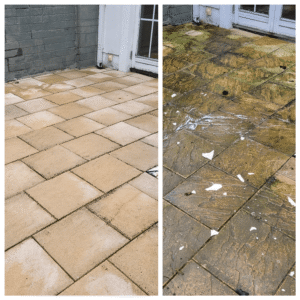Cobblelock Cleaning
Cobblelock driveways and pathways are a timeless and attractive feature for any home. However, without proper care, dirt, weeds, and stains can diminish their beauty. Regular cobblelock cleaning isn’t just about aesthetics—it prevents long-term damage and preserves your investment.
Below, we’ll share expert tips to keep your cobblestone looking pristine year-round.
Why Regular Cobblelock Cleaning Matters
Neglecting cobblelock paving can lead to:
Weed growth between joints
Staining from oil, rust, and organic matter
Deterioration of sand joints, leading to instability
Discoloration from dirt and moisture buildup
By following a consistent maintenance routine, you can extend the life of your cobblelock and keep it looking fresh and clean.
How to Clean Cobblelock Effectively
1. Sweep Regularly to Prevent Dirt Build-Up
Dirt, leaves, and debris settle between cobblelock joints, leading to weed growth and discoloration. Use a stiff-bristle broom or a leaf blower weekly to keep surfaces clean.
2. Choose the Right Cleaning Solution
Avoid harsh chemicals that erode sand joints. Instead, use a pH-neutral cleaner diluted with warm water. For eco-friendly stain removal:
White vinegar or baking soda for mild stains
Hydrogen peroxide or oxygen bleach for organic stains
3. Master Pressure Washing Techniques
Pressure washing is effective, but must be done correctly:
Use low pressure (under 1,500 PSI)
Hold the nozzle 12 inches above the surface
Use a wide-angle nozzle to prevent sand loss
4. Tackle Weeds Proactively
Prevent weed growth by:
Spraying weed-killing solutions or pouring boiling water
Using a saltwater spray (sparingly, as excessive salt can harm soil)
5. Remove Stains Immediately
Act fast to prevent permanent staining:
Oil/Grease: Soak up with cat litter, then scrub with dish soap
Rust: Use a cleaner with oxalic acid
Organic stains (leaves, moss, algae): Apply hydrogen peroxide or oxygen bleach
6. Re-Sand Joints Annually
Over time, sand between cobblelock joints wears away, causing instability. Refill the gaps with polymeric sand to:
Strengthen adhesion
Reduce weed growth
Improve water drainage
7. Apply a Protective Sealant
Every 2–3 years, apply a penetrating sealer to guard against:
Stains and UV damage
Frost and water absorption
Avoid glossy sealers, as they create a slippery surface.
8. Avoid Acidic or Abrasive Cleaners
Stay away from bleach or hydrochloric acid, as they:
Etch and weaken the cobblelock
Harm surrounding plants
9. Book a Professional Deep Cleaning Service
For stubborn grime or large driveways, a professional service with specialized equipment can:
Restore color and texture
Remove deep stains without damage
Extend the lifespan of your cobblelock
Seasonal Cobblelock Maintenance Tips
Spring & Summer:
Prioritize weed control and stain removal.
Fall:
Regularly remove leaves and debris to prevent moisture buildup.
Winter:
Use plastic shovels (not metal) for snow removal.
Avoid salt-based deicers to prevent surface damage.
FAQs on Cobblelock Cleaning
Q: Can I use a power washer on cobblelock?
Yes, but use low pressure to avoid washing away the sand between joints.
Q: How often should I reseal my cobblelock?
Every 2–3 years, or sooner if you notice fading or wear.
Q: What’s the best way to prevent weeds?
Sweep frequently and use polymeric sand to fill gaps.
Conclusion
Cobblelock cleaning requires a blend of routine maintenance and deep cleaning when needed. By following these expert tips, you’ll maintain a beautiful and long-lasting cobblelock surface that adds value to your home.
For tough stains or extensive cleaning, don’t hesitate to hire a professional.
Ready to Restore Your Cobblelock?
Share this guide with a neighbor!
Contact us today for a personalized cobblelock care quote!


